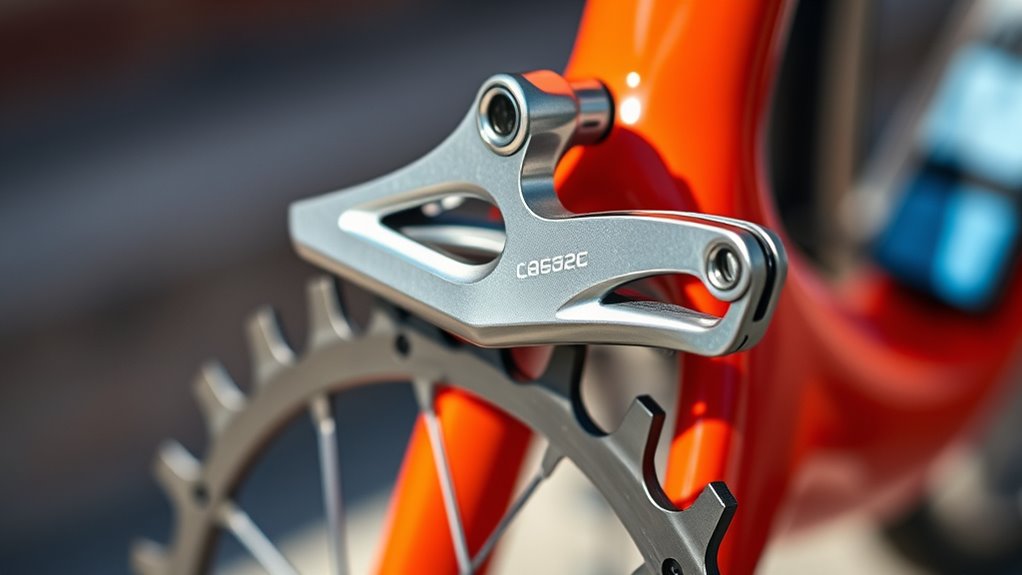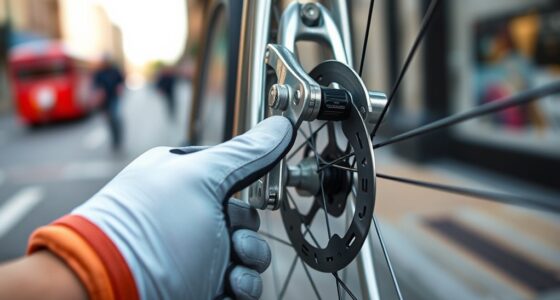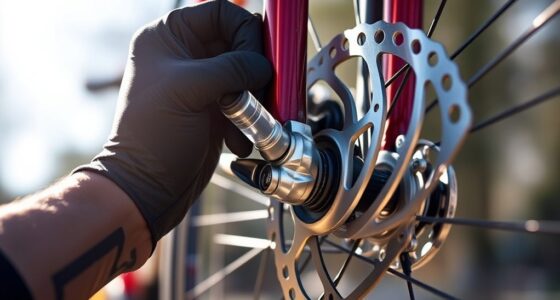To set up your front derailleur without rub, start by ensuring the hanger is perfectly aligned and the cage is parallel to the chainrings, with the outer plate 1-2 mm above the largest teeth. Adjust cable tension so shifting is smooth and responsive, then fine-tune the cage height and angle for clearance over each chainring. If you keep adjusting carefully, you’ll achieve silent, precise shifts—keep going, and you’ll master every step needed for a perfect setup.
Key Takeaways
- Ensure the derailleur cage is parallel to the chainrings for proper alignment.
- Adjust the derailleur height so the outer plate is 1-2 mm above the largest chainring teeth.
- Verify the derailleur hanger is straight to prevent misalignment and rubbing.
- Set cable tension correctly by shifting to the smallest chainring, then tightening the cable snugly.
- Fine-tune by shifting through all gears, adjusting cable tension with the barrel adjuster to eliminate rub.

Setting up your front derailleur properly is essential for smooth shifting and overall bike performance. When your derailleur is correctly aligned, shifting between gears becomes effortless, and you avoid annoying rubs or noise. The first step involves ensuring the gear alignment is precise. You want the derailleur cage parallel to the chainrings, with the outer plate just a millimeter or two above the teeth of the largest chainring. Use your hand to gently pivot the derailleur if needed, making sure it sits squarely and doesn’t tilt inward or outward. Proper gear alignment is vital because it guarantees that the chain moves smoothly from one chainring to another without rubbing against the derailleur cage or getting stuck. Take your time to double-check the alignment from different angles, because even a slight misalignment can cause shifting issues down the line. Additionally, verifying the derailleur hanger alignment can prevent many shifting problems and ensure the derailleur remains in proper position over time. Next, focus on cable tension. Adjusting cable tension is often the key to preventing rubbing and ensuring crisp, reliable shifts. Start by shifting the derailleur to the smallest chainring, then loosen the cable bolt to release any slack. Pull the cable taut with your fingers or a tool, then tighten the bolt securely. This initial tension sets the foundation for fine-tuning. You’ll want to test the shifting by moving to the largest chainring and back to the smallest, observing how the derailleur responds. If you notice rubbing or if it doesn’t shift smoothly, you may need to increase or decrease cable tension accordingly. Use the barrel adjuster if your bike has one; turning it clockwise reduces tension, while turning it counterclockwise increases it. Fine-tuning the cable tension allows you to dial in the perfect setting where the derailleur shifts cleanly without rubbing against the chain or frame.
Frequently Asked Questions
How Do I Adjust for Chain Cross-Chaining?
To fix chain cross-chaining, start by ensuring your chainring compatibility and check your derailleur hanger alignment. Shift to the smallest chainring and smallest sprocket, then inspect if the derailleur is centered and aligned with the cassette. Adjust the derailleur limit screws if needed, and make sure the derailleur cage is parallel to the chainring. Proper alignment prevents excessive wear and improves shifting, reducing cross-chaining issues.
Can I Use a Road Derailleur on a Mountain Bike?
Sure, you can slap a road derailleur on your mountain bike—if you enjoy gear compatibility headaches and derailleur incompatibility. While it might seem tempting, road derailleurs are designed for different gear ranges and cable pull ratios, making smooth shifting unlikely. For peak performance, stick with mountain bike-specific derailleurs that match your gear setup. Otherwise, you risk constant chain drops and frustration, not to mention potential damage to your bike.
What Tools Are Needed for Precise Setup?
To set up your front derailleur precisely, you’ll need a 5mm Allen wrench, a Phillips screwdriver, and a cable tensioner or indicator. First, adjust the derailleur’s height and angle, then use the screwdriver to set the limit screws. Next, fine-tune cable tension to match your gear ratio, ensuring smooth shifts without rub. Proper tools help achieve accurate alignment and peak performance.
How Often Should I Check Derailleur Alignment?
You should check your derailleur alignment every few hundred miles or after any impact, like a crash or bike fall. Ensure chainring compatibility and verify derailleur hanger alignment to prevent rubbing. Proper alignment keeps shifting smooth and reduces wear. Regular inspections help catch issues early, so you maintain ideal performance. Use an alignment tool for precise adjustments, and don’t forget to recheck after making adjustments or upgrading components.
Is It Necessary to Lubricate the Derailleur?
Think of your derailleur as a finely tuned engine—lubrication maintenance keeps it running smoothly. Yes, you should lubricate it regularly to prevent rust and ensure seamless shifting. After derailleur cleaning, apply a light bike-specific oil to the pivots and moving parts. This simple step reduces friction and prolongs your derailleur’s life, helping you ride confidently without unexpected hiccups. Remember, a well-lubricated derailleur is a happy derailleur.
Conclusion
Now that you’ve fine-tuned your front derailleur, you’re gently steering your bike toward smoother rides. With a little patience and a keen eye, you’ve crafted a setup that whispers rather than shouts, making every shift feel almost effortless. Remember, a perfectly tuned derailleur isn’t just about performance—it’s about enjoying the quiet confidence that comes with knowing your bike is in harmony. Keep riding smoothly, and let the journey be as enjoyable as the destination.









